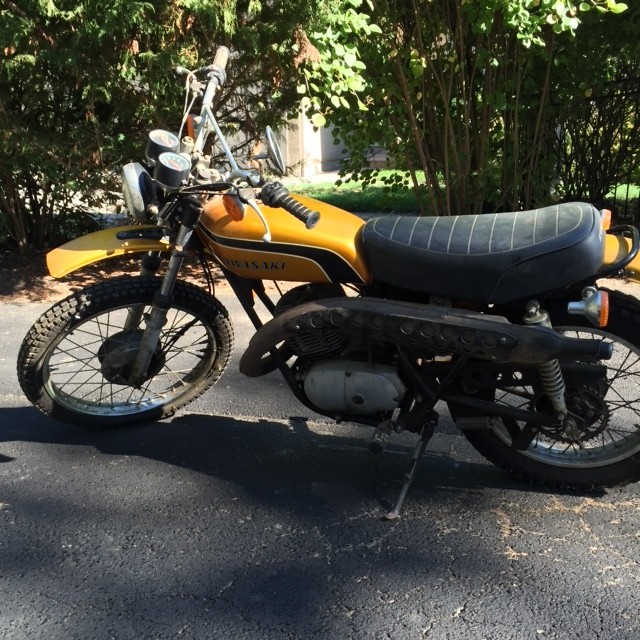Posts
394
Joined
10/20/2011
Location
Honeoye Falls, NY
US
Edited Date/Time
8/25/2017 8:12am
I just got this from a co-worker, a 1974 Kawasaki Bighorn 350:


It has less than 7500 miles on it, and was last used in the spring of 1983. It is solid overall, but I cringed when I found out that the tank was half full of gas... from 1983!
I cleaned the carb, and with some starting fluid, and it lit right up and sounds great!
Now I need to get the tank clean, as it is nasty! Any ideas on the best way to do this?
Any info on how this bike was, back in the day? It seemed like a rare bike.


It has less than 7500 miles on it, and was last used in the spring of 1983. It is solid overall, but I cringed when I found out that the tank was half full of gas... from 1983!
I cleaned the carb, and with some starting fluid, and it lit right up and sounds great!
Now I need to get the tank clean, as it is nasty! Any ideas on the best way to do this?
Any info on how this bike was, back in the day? It seemed like a rare bike.



































https://www.kbs-coatings.com/cycle-tank-sealer-kit.html
Try using mineral spirits and drip a length of chain (not motorcycle drive chain but something you'd use to lock your fence with) into the tank and slosh it around. Keep changing out the dirty chemical. I heard Evaporust works good too, but I've gotten by with the chain method more than once. Actually was able to remove a bad seal job with chain and MEK from a 79 KD100 tank.
My Dad had a 75 F9, would love to find another one someday.
The Shop
This process takes a long time. It typically takes me hours to completely clean a tank to where I am sure it is usable. You will never get it back to 100% new, but the important thing is that you do it long enough to remove anything that could be knocked loose. I highly recommend running a cheap inline fuel filter for the first several tank fulls.
In the past, I have had ideas to rig up some sort of vibratory plate using a palm sander. I think you could construct some sort of wood box to hold the tank and then attach the vibratory sander to the wood which would then let you just fill it with media and vibrate for hours on end. I just never got around to trying it. Then again, a regular vibratory sander may not be violent enough to do the job.
I do not recommend cream seal kits unless your tank is severely (i mean really bad shape) rusted. Cream seal kits are more headaches in the long run. I have cleaned many tanks w/o cream sealers and never had an issue as long as you spend the required time up front to do a good job.
Ancient riders from the Houston area might remember Robby Holbert riding a modified 350 Bighorn for A.J. Foyt's Kawasaki dealership back in 1971, before the F11/F12 MX bikes got here. Holbert ran up front on anything but possibly did fall off that Bighorn more often than his CZs or Huskys. Not a good offroad chassis.
My older brother bought an A1R framed Bighorn ,with the F81M lower end, 350cc top end from a local dealer here about 20 years ago.
It hung in the rafters of the shop after being crashed at Daytona in the Sportsman races around '71-72. A sprocket bolt had backed out, jammed against the swingarm, and crashed the rider at about 90 mph.
When it was purchased , my brother brought it home, cleaned the carb, fresh fuel, and it lit right off. It had a huge Mikuni hanging off the side, at least a 40mm. A noted two stroke Kawasaki tuner (Woody Kyle) mentioned he had only seen a few that had the cases machined to accept that big of carb.
He stated Irv Kanemoto did most of the ones he saw with that much carb on them.
Sadly, the motor was removed from the chassis, and traded off for Kawasaki Greenstreak 100cc parts, which never came through after the bike was sent out west. The engine remained on the shelf, until about 5 years ago, when it was sold off .
It was a cool bike, crashed up or not.
Post a reply to: Just picked this up : 1974 Kawasaki Bighorn 350...